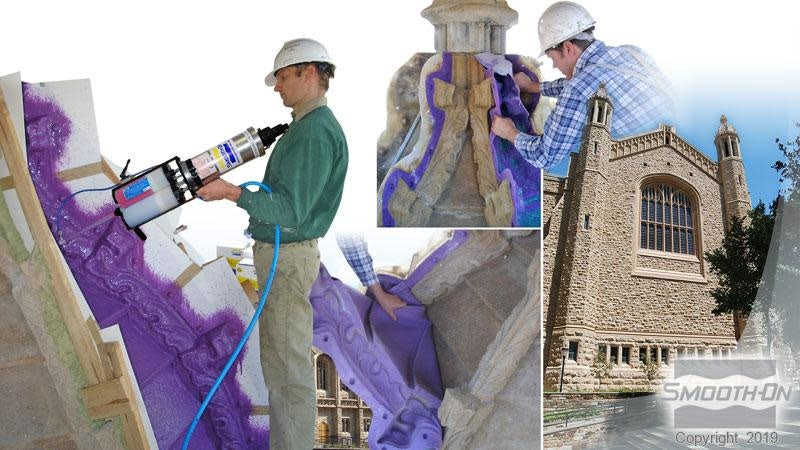Smooth-On
EZ-Spray 35 Silicone Cartidges Case of 5 1500ml (18.75 lbs. / 8.51 kg.)
EZ-Spray 35 Silicone Cartidges Case of 5 1500ml (18.75 lbs. / 8.51 kg.)
Low stock: 1 left
Couldn't load pickup availability
EZ~Spray™ 35 is a platinum cure silicone rubber developed specifically for spraying through the EZ~Spray™ Junior Cartridge System. With no or minimal surface preparation, EZ~Spray™ 35 can be sprayed onto vertical surfaces for making fast rubber molds of large surface areas. After a suitable thickness is attained, EZ~Spray™ 35 cures in 1 hour with negligible shrinkage to a durable mold rubber good for production casting resins, foams, concrete, plaster and other materials. Application of a support shell is achieved by spraying Smooth-On’s EZ~Spray™ Plastic over the rubber mold after it has fully cured. Read the EZ~Spray™ Junior manual prior to spraying.
Data At-A-Glance
| Mix Ratio By Volume | 1A:1B |
| Pot Life | 1.5 minutes |
| Cure Time | 1 hour |
| Shore Hardness | 35 A |
| Specific Gravity | 1.15 g/cc |
| Specific Volume | 24.1 cu. in./lb. |
| Color | Purple |
| Tensile Strength | 490 psi |
| Elongation @ Break | 415 % |
| Die B Tear Strength | 92 pli |
| Shrinkage | <.001 in. / in. |
| Mixed Viscosity | Sprayable |
Instructions
Safety - Store and use at room temperature (73°F/23°C). These products have a limited shelf life and should be used as soon as possible. Environmental humidity should be as low as possible. Good room size ventilation is essential. Wear safety glasses, long sleeves and rubber gloves to minimize contamination risk. Spraying should be done in a well-ventilated area. Breathing protection: Everyone in the spray area should wear an independent air supplied hood or NIOSH approved breathing mask.
Do Not Attempt To Spray Rubber Or Plastic Without First Reading The EZ~Spray™ Junior Manual!
Inhibition - Platinum silicones are especially susceptible to inhibition by a variety of contaminants (such as sulfur-based clays) resulting in tackiness at the pattern interface or a total lack of cure. If compatibility between the rubber and the surface is a concern, a small-scale test is recommended. Apply a small amount of rubber onto a non-critical area of the pattern. Inhibition has occurred if the rubber is gummy or uncured after the full cure time has passed.
Applying A Sealer / Release Agent - To prevent inhibition, a “barrier coat” of clear acrylic lacquer sprayed directly onto the pattern is usually effective. Allow to thoroughly dry. Although not usually necessary, a release agent will make demolding easier when casting into or over most surfaces. Ease Release™ 200 is suitable for releasing silicone from silicone. Mann Ease Release™ products are available from Smooth-On or your Smooth-On distributor. If casting silicone into silicone, use Ease Release 200™ only.
Because no two applications are quite the same, a small test application to determine suitability for your project is recommended if performance of this material is in question.
After material cartridge is loaded & prepared depress EZ-Spray Gun trigger and begin spraying.
Applying The Rubber - This product must be sprayed in layers. Generally, 2 - 4 layers (minimum 3/8”-1/2” or 1 cm thickness) is suitable for a working mold. The first layer, the detail coat, is a thin layer to capture model detail. Subsequent coats will add strength to the mold. Spray undercuts and recesses first. Have an extra pair of hands to brush rubber as it is applied. Let the first coat dry for two minutes at room temperature or when it becomes “tacky” before adding the next coat. Repeat until the necessary thickness is achieved. Do not allow rubber to fully cure between layers, as delaminating may result.
Curing - Allow the mold to cure for one hour at room temperature (773°F/23°C) before demolding. Do not cure rubber where temperature is less than 65°F/18°C. Post curing the rubber after rubber has cured at room temp. (applying heat—150°F/65°C for 4–6 hours) will increase physical properties and performance significantly.
Apply Support Shell - After all layers of rubber fully cure (1 hour) a support shell should be applied over the rubber mold to prevent the mold from distorting when casting into it. Use Smooth-On’s EZ~Spray™ Plastic to spray on a hard, durable and lightweight plastic shell. Follow directions given in the EZ~Spray™ Junior manual.
Using The Mold - A release agent is not necessary; however using a release agent prior to casting lengthens the production life of any rubber mold. The type of release agent to use depends on the material being cast. Universal™ Mold Release is good for releasing resins recommended for most applications and is available from Smooth-On or your local distributor.
Mold Performance & Storage - Fully cured molds are tough, durable and will perform if properly used and stored. The physical life of the mold depends on how you use it (materials cast, frequency, etc.). Casting abrasive materials such as concrete will eventually erode mold detail, while casting non-abrasive materials (wax) will not affect mold detail. Using the right release agent is essential in all cases. Contact Smooth-On to discuss your particular application. Before storing, the mold should be cleaned with a soap solution and wiped fully dry. Two part (or more) molds should be assembled. Molds should be stored on a level surface in a cool, dry environment. Do not stack molds; expose them to moisture or UV light.
Share

- Choosing a selection results in a full page refresh.
- Opens in a new window.

